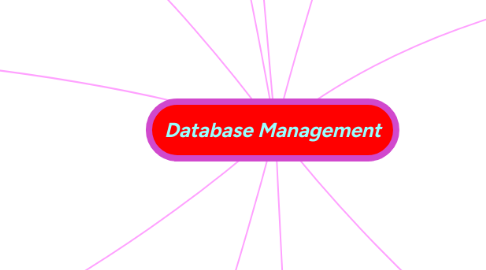
1. Database Management Systems
1.1. A data dictionary contains data about each file in the database and each field in those files
1.1.1. New node
1.2. A DBMS provides several tools that allow users and programs to retrieve and maintain data in the data in the database
1.2.1. Query language
1.2.2. Query by example
1.2.3. Form
1.2.4. Report generator
1.3. A query language consists of simple, English-like statements that allow users to specify the data to display, print, or store
1.4. Query by example (QBE) provides a GUI to assist users with retrieving data
1.5. A form is a window on the screen that provides areas for entering or modifying data in a database
1.6. A report generator allows users to design a report on the screen, retrieve data into the report design, and than display or print the report
1.7. A DMBS Provides a variety of techniques to restore the database to a usable form in case it is damage or destroyed
1.7.1. backup
1.7.2. log
1.7.3. Recovery
1.7.4. Continuous backup
2. The Hierarchy of Data
2.1. A character is one byte
2.1.1. Number, letters, space, punctuation marks, or other symbols
2.2. A field is a combination of one or more related characters
2.2.1. Field name
2.2.2. Field size
2.2.3. Data type
2.3. Common data types include
2.3.1. Text
2.3.2. Numeric
2.3.3. Auto Number
2.3.4. Currency
2.3.5. Date
2.3.6. Memo
2.3.7. Yes/No
2.3.8. Hyperlink
2.3.9. Object
2.3.10. Attachment
2.4. A record is group of related fields A primary key uniquely identifies each record
2.5. A data file is a collection of related records
3. Maintaining Data
3.1. File maintenance refers to the procedures that keep data current
3.1.1. Adding records
3.1.2. Modifying records
3.1.3. Deleting records
3.2. Users add new records to a file when they obtain new data
3.3. Validation compares data with a set of rules or values to find out if the data is correct
3.3.1. Alphabetic/Numeric Check
3.3.2. Range check
3.3.3. Consistency check
3.3.4. Completeness check
3.3.5. check digit
3.3.6. Other checks
3.4. Users modify to correct inaccurate data or update old data
3.5. When a record no longer is needed, a user deletes it from a file
4. File Processing Versus Databases
4.1. File processing system
4.1.1. Each department has its own set of files
4.1.2. Used for many years
4.1.3. Have data redundancy
4.1.4. Isolate data
4.2. Database approach
4.2.1. Programs and users share data
4.2.2. Reduce data redundancy
4.2.3. Improve
4.2.4. New node data integrity
4.2.5. Share data
4.2.6. Allows easier access
4.2.7. Reduces development time
4.2.8. Can be more vulnerable
5. Web Databases
5.1. Databases on the Web allow you to
5.1.1. Shop for products or services
5.1.2. Buy or sell stocks
5.1.3. Search for a job
5.1.4. Make airline reservations
5.1.5. Register for college classes
5.1.6. Check semester grades
6. Summary
6.1. How data and information are valuable assets to an organization
6.2. Methods for maintaining high quality data
6.3. Advantages of organizing data in a database
6.4. Various types of databases
6.5. Roles of the database analysts and administrators
6.6. Assessing the quality of valuable information
7. Objectives Overview
7.1. Define the term,database,and explain how a database interacts with data and information
7.2. Define the term,data integrity, and describe the qualities of valuable information
7.3. Discuss the terms character, field ,record and file
7.4. Describe file maintenance techniques and validation techniques
7.5. Differentiate between a file processing approach and the database approach
7.6. Discuss the functions common to most database management systems
7.7. Describe characteristics of relational, object oriented, and multidimensional databases
7.8. Explain how to access Web databases
7.9. Identify database design guidelines and discuss the responsibilities of database analysts and administrators
8. Databases, Data, and Information
8.1. Database
8.1.1. Collection of data organized in a manner that allows access, retrieval, and use of that data
8.2. Data
8.2.1. Collection of unprocessed items
8.2.1.1. text
8.2.1.2. Numbers
8.2.1.3. Images
8.2.1.4. Audio
8.2.1.5. Video
8.3. Information
8.3.1. processed data
8.3.1.1. Documents
8.3.1.2. Audio
8.3.1.3. Images Video
8.4. Database software, often called a database management system (DBMS), allows users
8.4.1. Create a computerized database
8.4.2. Add, modify, and delete data
8.4.3. Sort and retrieve data
8.4.4. Create forms and reports from the data
8.5. Data integrity identifies the quality of the datav
8.6. Garbage in, garbage out(GIGO) points out the accuracy of a computer's output depends on the accuracy of the input
8.7. Valuable information should have the following characteristics
9. Relational, Object-Oriented, and Multidimensional Databases
9.1. A data model consists of rules and standards that define how the database organizes data
9.2. A relational database stores data in tables that consist of rows and columns
9.2.1. Each row has a primary key
9.2.2. Each column has a unique name
9.3. A relationship is a link within the data
9.4. Structured Query Language (SQL) is a query language that allows to manage, update, and retrieve data
9.5. An object-oriented database (OODB) stores data in objects
9.6. Examples of applications applications appropriate for an object-oriented database include
9.6.1. Multimedia database
9.6.2. Groupware database
9.6.3. Computer aided design database
9.6.4. Hypertext database
9.7. A multidimensional database can store data in more than two dimensions of data
9.8. A data warehouse is a huge database that stores and manages the data required to analyze historical and current transactions
10. Database Administration
10.1. It is important to have a carefully designed database
10.2. Database analysts and administrators are responsible for managing and coordinating all database activities
10.2.1. Database Analyst(DA)
10.2.2. Database Administrator(DBA)
10.3. Employees should learn how to use the data in the database effectively
10.3.1. Interact with database
10.3.2. Identify new data for the database
10.3.3. Maintain the database
